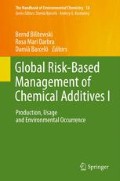Abstract
The leather industry is a traditional industrial sector. The industry uses both a high variety and high amount of chemicals during the production of leather from raw hides and skins. The chemicals used will end up in the product, in the environment (wastewater, solid waste, air) and in by-products. This chapter describes how a modern tannery in Sweden is working with the risk management of chemicals in order to reduce the health and safety risks at the company and also to reduce the environmental impact of the company and avoiding hazardous chemicals in the product. The tannery is using 350 different chemicals in the different processes and in general the tannery adds 3 kg of chemicals for every kilogram of leather that is produced. The tannery has implemented environmental management systems and has a very good control of all processes in the tannery. The chapter focuses on how the tannery assesses new chemicals before they are introduced, how the tannery substitutes potential dangerous chemicals by less dangerous alternatives, how the tannery reduces the impact of chemicals to the environment by the use of best available techniques complemented by treatment facilities such as a newly built wastewater treatment plant and finally how the company monitors the content of certain chemicals in the finished leather.
Access this chapter
Tax calculation will be finalised at checkout
Purchases are for personal use only
Abbreviations
- BAT:
-
Best available techniques
- BBP:
-
Butylbenzylphtalate
- BDE:
-
Bromodiphenyl ether
- BREF:
-
BAT reference document
- CAS:
-
Chemical abstracts service
- CLP:
-
Classification, labelling and packaging of substances and mixtures
- DBP:
-
Dibutylphtalate
- DBT:
-
Dibutyl tin
- DEHP:
-
Di-(2-ethylhexyl)-phtalate
- DIBP:
-
Di-iso-butylphtalate
- ECHA:
-
European Chemicals Agency
- EINECS:
-
European inventory of existing chemical substances
- EU:
-
European Union
- GADSL:
-
Global automotive declarable substance list
- GASG:
-
Global automotive stakeholders group
- GHS:
-
Globally harmonized system of classification and labelling of chemicals
- HBCDD:
-
Hexabromocyclododecane
- NP:
-
Nonylphenol
- NPE:
-
Nonylphenol ethoxylate
- LGR:
-
Lederinstitut Gerberschule Reutlingen
- PAH:
-
Polycyclic aromatic hydrocarbons
- PBB:
-
Polybrominated biphenyls
- PCP:
-
Pentachlorophenol
- PFOS:
-
Perfluorooctane sulphonate
- REACH:
-
Registration, evaluation, authorization and restriction of chemicals
- SCCP:
-
Short chained chlorinated paraffins
- SVHC:
-
Substance of very high concern
- TBT:
-
Tributyl tin
- TCEP:
-
Tris(2-chloroethyl)phosphate
- TCMTB:
-
2-(Thiocyanomethylthio)benzothiazole
- TeCP:
-
Tetrachlorophenol
- TEPA:
-
Tris-/aziridinyl)-phosphinoxide
- TPhT:
-
Triphenyltin
- TRIS:
-
Tri-(2,3-dibromopropyl)-phosphate
- VOC:
-
Volatile organic compound
References
European Commission (2006) Regulation No 1907/2006 of the European Parliament and of the Council of 18 December 2006 concerning the Registration, Evaluation, Authorisation and Restriction of Chemicals (REACH)
PRIO – A tool for risk reduction of chemicals. Swedish Chemical Agency Web. Available at: http://www.kemi.se. Accessed 25 February 2011
European Commission (2008) Directive 2008/105/EC of the European Parliament and of the Council of 16 December 2008 on environmental quality standards in the field of water policy
Global Automotive Declarable Substance List website. Available at: http://www.gadsl.org. Accessed 25 February 2011
European Commission (2010) Directive 2010/75/EU of the European Parliament and of the Council of 24 November 2010 on industrial emissions (integrated pollution prevention and control)
European commission (2009) Regulation no 552/2009 of 22 June 2009 amending Regulation (EC) No 1907/2006 of the European Parliament and of the Council on the Registration, Evaluation, Authorisation and Restriction of Chemicals (REACH) as regards Annex XVII
European Commission (1998) Directive 98/7/EC of the European Parliament and of the Council of 16 February 1998 concerning the placing of biocidal products on the market (Biocidal Products Directive)
Rydin S (2006) Environment in focus at Elmo Leather. Leather International August/September 2006
Rydin S, Svensson L (2006) Innovative waste water treatment plant at Elmo Leather AB. In: Proceedings of the IULTCS II. Eurocongress Istanbul, Turkey
Oeko-Tex 100 Eco-label website. Available at: http://www.oeko-Tex100_PUBLIC/index.asp?cls=21. Accessed 25 February 2011
Author information
Authors and Affiliations
Corresponding author
Editor information
Editors and Affiliations
Rights and permissions
Copyright information
© 2011 Springer-Verlag Berlin Heidelberg
About this chapter
Cite this chapter
Rydin, S. (2011). Risk Management of Chemicals in the Leather Sector: A Case Study from Sweden. In: Bilitewski, B., Darbra, R., Barceló, D. (eds) Global Risk-Based Management of Chemical Additives I. The Handbook of Environmental Chemistry(), vol 18. Springer, Berlin, Heidelberg. https://doi.org/10.1007/698_2011_108
Download citation
DOI: https://doi.org/10.1007/698_2011_108
Published:
Publisher Name: Springer, Berlin, Heidelberg
Print ISBN: 978-3-642-24875-7
Online ISBN: 978-3-642-24876-4
eBook Packages: Earth and Environmental ScienceEarth and Environmental Science (R0)

